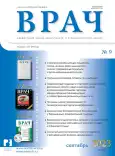Mechanotherapy and virtual reality technologies in the rehabilitation of patients with post-covid syndrome: impact on endurance, muscle strength, gait and balance
- Authors: Ansokova М.A.1, Marchenkova L.A.1, Fesyun A.D.1, Yurova O.V.1
-
Affiliations:
- National Medical Research Center for Rehabilitation and Balneology of the Ministry of Health of Russia
- Issue: Vol 34, No 9 (2023)
- Pages: 55-60
- Section: From Practice
- URL: https://journals.eco-vector.com/0236-3054/article/view/604158
- DOI: https://doi.org/10.29296/25877305-2023-09-11
- ID: 604158
Cite item
Abstract
Objective. To investigate the effectiveness of the use of mechanotherapy and virtual reality technologies in increasing muscle strength, motor activity and balance in patients with post-COVID syndrome.
Material and methods. The study included 120 patients who underwent a novel coronavirus infection COVID-19, aged 40 to 70 years, with manifestations of post-COVID syndrome. The rehabilitation program for patients of the main group (n=60) included 10 sessions on a robotic simulator with biofeedback for training the muscles of the lower extremities, 10 sessions of interactive balance therapy and 10 sessions on an interactive rehabilitation system with virtual reality technology against the background of basic treatment. In the control group (n=60), patients received only basic treatment. The effectiveness of the treatment was assessed using functional tests, stabilometry, assessment of walking speed on the C-mill ergometer, and tensodynamometry.
Results. Stabilometry indicators in the main group after the end of the rehabilitation course were significantly better than in the control group in terms of parameters: frontal deviation with open (χ2=13.8; p=0.000) and closed eyes (χ2=11.4; p=0.000) ; sagittal displacement with closed eyes (χ2=4.4; p=0.041); the speed of movement of the center of pressure with open (χ2=5.2; p=0.026); the rate of change in the area of the statokinesiogram with open (χ2=7.5; p=0.007) and closed eyes (χ2=7.1; p=0.009). Also, in the main group after treatment, the maximum extension force of the right leg was higher than in the control group (1245.5 N versus 1241 N; p=0.008) and the maximum extension force of the left leg (1471.5 N versus 1257 N; p=0.013). In patients in both groups, walking speed increased: from 1 m/s to 1.6 m/s on average in the main group (p<0.000); from 1.1 to 1.4 in the control (p<0.001), and the step length increased: from 0.37 m to 0.7 m (p<0.001) and from 0.45 to 0.6 m (p=0.019), respectively. In the dynamics in the main group, both indicators of both parameters were better than in the control group (p=0.013 and p=0.023, respectively).
Conclusion. The use of mechanotherapy and virtual reality technologies in the framework of medical rehabilitation programs for patients with post-COVID syndrome improves motor function, increases muscle strength, improves balance and gait quality.
Full Text
About the authors
М. A. Ansokova
National Medical Research Center for Rehabilitation and Balneology of the Ministry of Health of Russia
Email: marchenkovala@nmicrk.ru
ORCID iD: 0000-0001-8888-6149
Russian Federation, Moscow
L. A. Marchenkova
National Medical Research Center for Rehabilitation and Balneology of the Ministry of Health of Russia
Email: marchenkovala@nmicrk.ru
ORCID iD: 0000-0003-1886-124X
MD
Russian Federation, MoscowA. D. Fesyun
National Medical Research Center for Rehabilitation and Balneology of the Ministry of Health of Russia
Email: marchenkovala@nmicrk.ru
ORCID iD: 0000-0003-3097-8889
MD, Associate Professor
Russian Federation, MoscowO. V. Yurova
National Medical Research Center for Rehabilitation and Balneology of the Ministry of Health of Russia
Author for correspondence.
Email: marchenkovala@nmicrk.ru
ORCID iD: 0000-0001-7626-5521
MD, Professor
Russian Federation, MoscowReferences
- Alhumayn A., Alsaif I., Enabi J. et al. A systematic review of the systematic review of post COVID-19 syndrome. JMLPH. 2022; 2 (1): 64–9.
- Марченкова Л.А. Гильмутдинова И.Р. Тяжесть, особенности течения и принципы реабилитации COVID-19 у пациентов с отягощенным соматическим анамнезом. Вопросы курортологии, физиотерапии и лечебной физической культуры. 2022; 99 (3-2): 133–4 [Marchenkova L.A. Gil'mutdinova I.R. Tyazhest', osobennosti techeniya i printsipy reabilitatsii COVID-19 u patsientov s otyagoshchennym somaticheskim anamnezom. Problems of Balneology, Physiotherapy, and Exercise Therapy. 2022; 99 (3-2): 133–4 (in Russ.)].
- Moreno-Pérez O., Merino E., Leon-Ramirez J.M. et al. Post-acute COVID-19 syndrome. Incidence and risk factors: a Mediterranean cohort study. J Infect. 2021; 82 (3): 378–8. doi: 10.1016/j.jinf.2021.01.004
- Office for National Statistics (ONS). The prevalence of long COVID symptoms and COVID-19 complications. URL: https://www.ons.gov.uk/news/statementsandletters/theprevalenceoflongcovidsymptomsandcovid19complications
- Venkatesan P. NICE guideline on long COVID. Lancet Respir Med. 2021; 9 (2): 129. doi: 10.1016/S2213-2600(21)00031-X
- Grigoletto I., Cavalheri V., Lima F.F. et al. Recovery after COVID-19: The potential role of pulmonary rehabilitation. Braz J Phys Ther. 2020; 24 (6): 463–4. doi: 10.1016/j.bjpt.2020.07.002
- Sanchez-Ramirez D., Normand K., Zhaoyun Y. et al. Long-Term Impact of COVID-19: A Systematic Review of the Literature and Meta-Analysis. Biomedicines. 2021; 9 (8): 900. doi: 10.3390/biomedicines9080900
- Schiavi M., Fugazzaro S., Bertolini A. et al. «Like before, but not exactly»: The Qualy-REACT qualitative inquiry into the lived experience of long COVID. BMC Public Health. 2022; 22 (1): 599. doi: 10.1186/s12889-022-13035-w
- Wilson C. Concern coronavirus may trigger post-viral fatigue syndromes. New Sci. 2020; 246 (3278): 10–1. doi: 10.1016/S0262-4079(20)30746-6
- Wong T.L., Weitze D.J. Long COVID and Myalgic Encephalomyelitis/Chronic Fatigue Syndrome (ME/CFS) – A Systematic Review and Comparison of Clinical Presentation and Symptomatology. Medicina (Kaunas). 2021; 57 (5): 418. doi: 10.3390/medicina57050418
- McNeary L., Maltser S., Verduzco-Gutierrez M. Navigating coronavirus disease 2019 (Covid-19) in physiatry: a CAN Report for inpatient rehabilitation facilities. PM R. 2020; 12 (5): 512–5. doi: 10.1002/pmrj.12369
- Yang F., Liu N., Hu J.Y. et al. Pulmonary rehabilitation guidelines in the principle of 4S for patients infected with 2019 novel coronavirus (2019-nCoV). Zhonghua Jie He He Hu Xi Za Zhi. 2020; 43 (3): 180–2. doi: 10.3760/cma.j.issn.1001-0939.2020.03.007
- Agostini F., Mangone M., Ruiu P. et al. Rehabilitation setting during and after COVID-19: An overview on recommendations. J Rehabil Med. 2021; 53 (1): jrm00141. doi: 10.2340/16501977-2776
- Временные клинические рекомендации: Медицинская реабилитация при новой коронавирусной инфекции COVID-19). Версия 01.11.2022. М.: Минздрав России, 2022; 264 с. [Vremennye klinicheskie rekomendatsii: Meditsinskaya reabilitatsiya pri novoi koronavirusnoi infektsii COVID-19). Versiya 01.11.2022. M.: Minzdrav Rossii, 2022; 264 р. (in Russ.)].
Supplementary files







